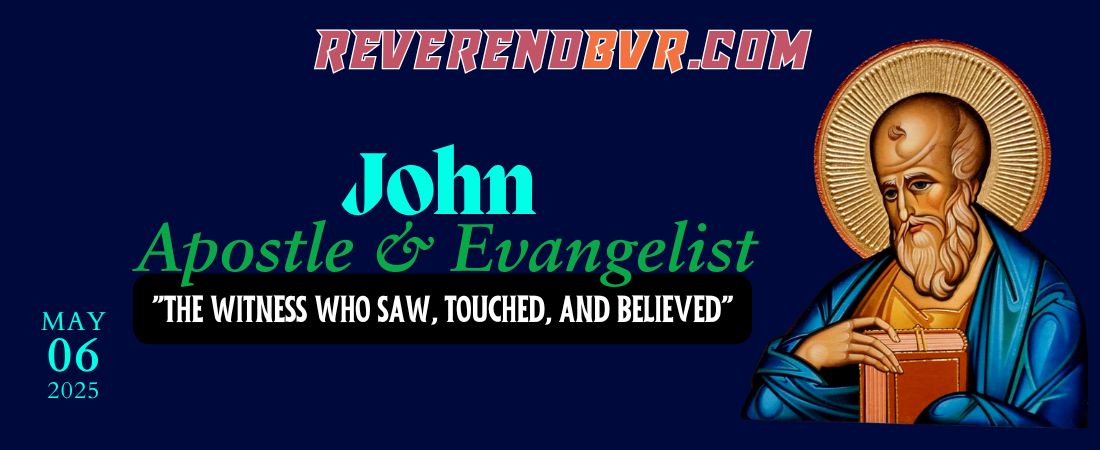Theme: JOHN, Apostle and Evangelist – “The Witness Who Saw, Touched, and Believed”
Date: May 6th 2025, Tuesday.
Introduction: A Theological Portrait of the Beloved Disciple
Among the twelve apostles, John stands uniquely as a theologian, mystic, and witness—a man whose proximity to Jesus was not only physical but deeply spiritual. Described as “the disciple whom Jesus loved” (John 21:20), John is a figure whose identity embodies intimacy with Christ, clarity of theological vision, and courage in the face of mystery. This post reflects on the apostolic witness of John through an exegetical and theological lens, guided by Scripture, and seeks to inspire believers today to deepen their own encounter with the Risen Lord.
1. John’s Testimony: Eyewitness of the Incarnate Word (1 John 1:1–4)
Context: Likely written from Ephesus in the late 1st century, 1 John addresses heresies such as Gnosticism, which denied the true humanity of Christ.
John opens his epistle not with abstract doctrine but with tangible experience: “That which was from the beginning, which we have heard, which we have seen with our eyes, which we have looked at and our hands have touched—this we proclaim concerning the Word of life” (1 John 1:1).
John affirms the historicity and physicality of Jesus Christ. The Word, who “was with God” and “was God” (John 1:1), appeared in the flesh. His testimony dismantles dualism, affirming that the eternal touched the temporal.
Takeaway: Christian faith is grounded not in ideology but in historical revelation. The Incarnation is the wellspring of all Christian theology.
2. The Desire to See God’s Glory (Exodus 33:18–23)
Moses’ plea—”Show me your glory“(kāḇôḏ in Hebrew) is met with both revelation and limitation: “You cannot see my face, for no one may see me and live” (v. 20). Yet John proclaims that divine glory has now been revealed: “We have seen his glory, the glory of the One and Only Son, who came from the Father, full of grace and truth” (John 1:14).
What was once hidden is now unveiled in Christ—humble, compassionate, sacrificial.
3. Seeking the Face of God (Psalm 27)
Psalm 27 is a psalm of David expressing trust amid adversity. “Your face, Lord, I will seek” (v. 8). This reflects John’s longing—not just to seek, but to abide in God’s presence. “God is light; in him there is no darkness at all” (1 John 1:5)
Reflection: Walking with God means walking in light, truth, and fellowship—even amid life’s shadows.
4. The Intimate Witness (John 21:20-25)
This happens during the Post-resurrection appearance by the Sea of Galilee. When Peter inquires about John’s future, Jesus responds: “If I want him to remain alive until I return, what is that to you? You must follow me” (v. 22).
John’s personal path is not for speculation. His role is to testify: “This is the disciple who testifies to these things… We know that his testimony is true” (v. 24). “If every one of them were written down… even the whole world would not have room for the books that would be written” (v. 25)
Insight: John’s Gospel is not exhaustive, but a revelatory invitation—to see, believe, and live.
5. Our Takeaway: Living as Contemporary Witnesses in this modern technology world.
John’s life calls us to be witnesses—not just in theology, but in our lived experience. In a skeptical world, we proclaim:
- Christ is not a myth, but our very life.
- To seek God’s face is our highest calling.
- True glory is found not in status, but in God’s presence.
Let us live as witnesses—in love, light, and life.
6. Who Was John the Apostle and Evangelist? Origins and Background:
- Son of Zebedee, brother of James (cf. Matthew 4:21–22).
- Galilean fisherman from Bethsaida or Capernaum.
- Part of Jesus’ inner circle—witness to:
- The Transfiguration (Matthew 17:1–9)
- The Agony in Gethsemane (Mark 14:33)
- The Crucifixion, where Jesus entrusted him with Mary (John 19:26–27)
7. John’s Authorship and Writings
| S. No | Biblical Work | Key Themes |
| 1 | Gospel of John | Divine identity of Jesus, light and life, Logos theology |
| 2 | 1 John | Fellowship, walking in light, truth, love |
| 3 | 2 John | Warning against heresy, living in truth and love |
| 4 | 3 John | Hospitality, rebuke of arrogance |
| 5 | Revelation | Apocalyptic visions of Christ’s triumph |
Likely written from Ephesus, around AD 85–95.
8. Later Life and Death
- Tradition holds John lived to old age, unlike other martyred apostles.
- Survived being boiled in oil (Tertullian); exiled to Patmos (Revelation 1:9).
- Returned to Ephesus, died peacefully.
- Buried near Ephesus; Basilica of Saint John built over his tomb.
9. Updated Summary Table: Expanded Insights on John the Apostle
| S. No | Aspect | Details |
| 1 | Name & Family | Son of Zebedee, Elder Brother of James the Apostle (Matthew 10:2; Mark 3:17), who was martyred early (Acts 12:2); mother possibly Salome, one of the women present at the cross (Matthew 27:56; Mark 15:40; John 19:25). |
| 2 | Occupation | Fisherman, apostle, teacher |
| 3 | Key Locations | Galilee, Jerusalem, Patmos, Ephesus |
| 4 | Major Writings | Gospel of John, 1–3 John, Revelation |
| 5 | Theological Focus | High Christology, love, truth, light, eternal life |
| 6 | Gospel Style | Symbolic, reflective, contrasts light/darkness |
| 7 | Death and Legacy | Died a natural death in Ephesus |
| 8 | Feast Days | Dec 27 (West), May 8 (East – translation of relics) |
10. Summary Table: Key Insights on John the Apostle
| S. No | Aspect | Biblical Reference | Significance |
| 1 | Eyewitness of the Word | 1 John 1:1–4 | Physical and divine reality of Christ |
| 2 | Seeker of Glory | Exodus 33:18–23 | Fulfilled in Christ’s incarnate glory |
| 3 | Spiritual Confidence | Psalm 27 | Trust in God’s presence amid fear |
| 4 | Beloved Disciple | John 21:20–25 | Relational heart of discipleship |
| 5 | Theological Legacy | Gospel of John, Revelation | Symbolic depth guiding Church |
11. Prayer
Gracious and Eternal God, We thank You for the life and witness of John, Apostle and Evangelist. In his words, You have shown us the mystery of the Incarnation. In his testimony, You have called us into fellowship with You. Lord, give us the courage to walk in the light, to seek Your face, and to proclaim what we have seen and heard. In times of trouble, be our stronghold. In times of doubt, be our truth. Let Your glory pass before us—not to terrify, but to transform. As we walk the paths You have called us to, may we, like John, remain close to the heart of Jesus. Teach us to love, to witness, and to abide. In the name of the Word made flesh, Jesus Christ our Lord. Amen.
12. Bibliography
- Barrett, C.K. The Gospel According to St. John. London: SPCK, 1978.
- Brown, Raymond E. The Gospel and Epistles of John: A Concise Commentary. Collegeville: Liturgical Press, 1988.
- Carson, D.A. The Gospel According to John. Grand Rapids: Eerdmans, 1991.
- Keener, Craig S. The Gospel of John: A Commentary. 2 vols. Peabody, MA: Hendrickson, 2003.
- Kostenberger, Andreas J. A Theology of John’s Gospel and Letters. Grand Rapids: Zondervan, 2009.
- Marshall, I. Howard. The Epistles of John. Grand Rapids: Eerdmans, 1978.
- Morris, Leon. The Gospel According to John. Rev. ed. Grand Rapids: Eerdmans, 1995.
- Witherington, Ben. John’s Wisdom: A Commentary on the Fourth Gospel. Louisville: Westminster John Knox Press, 1995.
For more sermons and biblical reflections, visit:
🌐 www.reverendbvr.com/sermons

